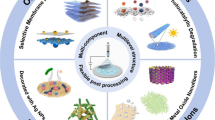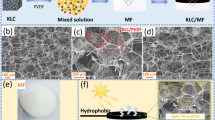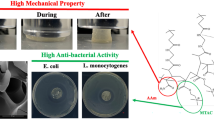Abstract
Electrospun hollow polymeric microfibers (microtubes) were evaluated as an encapsulation method for the atrazine degrading bacterium Pseudomonas sp. ADP. Pseudomonas sp. ADP cells were successfully incorporated in a formulation containing a core solution of polyethylene oxide dissolved in water and spun with an outer shell solution made of polycaprolactone and polyethylene glycol dissolved in a chloroform and dimethylformamide. The resulting microtubes, collected as mats, were partially collapsed with a ribbon-like structure. Following encapsulation, the atrazine degradation rate was low (0.03 ± 0.01 mg atrazine/h/g fiber) indicating that the electrospinning process negatively affected cell activity. Atrazine degradation was restored to 0.5 ± 0.1 mg atrazine/h/g fiber by subjecting the microtubes to a period of growth. After 3 and 7 days growth periods, encapsulated cells were able to remove 20.6 ± 3 and 47.6 ± 5.9 mg atrazine/g mat, respectively, in successive batches under non-growth conditions (with no additional electron donor) until atrazine was detected in the medium. The loss of atrazine degrading capacity was regained following an additional cell-growth period.




Similar content being viewed by others
References
Benotti MJ, Trenholm RA, Vanderford BJ, Holady JC, Stanford BD, Snyder SA (2009) Pharmaceuticals and endocrine disrupting compounds in US drinking water. Environ Sci Technol 43:597–603
Park J, Feng Y, Ji P, Voice TC, Boyd SA (2003) Assessment of bioavailability of soil-sorbed atrazine. Appl Environ Microbiol 69:3288–3298
Smith D, Alvey S, Corwley DE (2005) Cooperative catabolic pathways within an atrazine-degrading enrichment culture isolated from soil. FEMS Microbiol Ecol 53:265–273
Topp E (2001) A comparison of three atrazine-degrading bacteria for soil bioremediation. Biol Fertil Soils 33:529–534
Katz I, Dosoretz CG, Mandelbaum RT, Green M (2001) Atrazine degradation under denitrifying conditions in continuous culture of Pseudomonas ADP. Water Res 35:3272–3275
Mandelbaum RT, Allan DL, Wackett LP (1995) Isolation and characterization of a Pseudomonas sp. that mineralizes the s-triazine herbicide atrazine. Appl Environ Microbiol 61:1451–1457
Wyss A, Boucher J, Montero A, Marison I (2006) Micro-encapsulated organic phase for enhanced bioremediation of hydrophobic organic pollutants. Enzyme Microb Tech 40:25–31
Herzberg M, Dosoretz CG, Tarre S, Green M (2003) Patchy biofilm coverage can explain the potential advantage of BGAC reactors. Environ Sci Technol 37:4274–4280
Silva E, Fialho AM, Correia ISA, Burns RG, Shaw LJ (2004) Combined bioaugmentation and biostimulation to clean up soil contaminated with high concentrations of atrazine. Environ Sci Technol 38:632–637
Macias-Flores A, Tafoya-Garnica A, Ruiz-Ordaz N, Salmeron-Alcocer A, Juarez-Ramirez C, Ahuatzi-Chacon D, Mondragon-Parada ME, Galindez-Mayer J (2009) Atrazine biodegradation by a bacterial community immobilized in two types of packed-bed biofilm reactors. World J Microbiol Biotechnol 25:2195–2204
Reitti-Shati M, Ronen D, Mandelbaum RT (1996) Atrazine degradation by Pseudomonas sp. strain ADP entrapped in sol gel glass. J Sol-Gel Sci Technol 7:77–79
Siripattanakul S, Wirojanagud W, McEvoy J, Khan E (2008) Effect of cell-to-matrix ratio in polyvinyl alcohol immobilized pure and mixed cultures on atrazine degradation. Water Air Soil Pollut Focus 8:257–266
Vancov T, Jury K, Van Zwieten L (2005) Atrazine degradation by encapsulated Rhodococcus erythropolis NI86/21. J Appl Microbiol 99:767–775
Dror Y, Kuhn J, Avrahami R, Zussman E (2008) Encapsulation of enzymes in biodegradable tubular structures. Macromolecules 41:4187–4192
Klein S, Kuhn J, Avrahami R, Tarre S, Beliavski M, Green M, Zussman E (2009) Encapsulation of bacterial cells in electrospun microtubes. Biomacromolecules 10:1751–1756
Mandelbaum RT, Wackett LP, Allan DL (1993) Mineralization of the s-triazine ring of atrazine by stable bacterial mixed cultures. Appl Environ Microbiol 59:1695–1701
Theron A, Zussman E, Yarin AL (2001) Electrostatic field-assisted alignment of electrospun nanofibers. Nanotechnology 12:384–390
Arinstein A, Zussman E (2007) Post processes in tubular electrospun nanofibers. Phys Rev E 76:056303
Arinstein A, Avrahami R, Zussman E (2009) Buckling behavior of electrospun microtubes: a simple theoretical model and experimental observations. J Phys D Appl Phys 42:015507
Newcombe DA, Crowley DE (1999) Bioremediation of atrazine-contaminated soil by repeated applications of atrazine-degrading bacteria. Appl Microbiol Biotechnol 51:877–882
Zhao S, Arthur EL, Coats JR (2003) Influence of microbial inoculation (Pseudomonas sp. strain ADP), the enzyme atrazine chlorohydrolase, and vegetation on degradation of atrazine and metolachlor in soil. J Agric Food Chem 51:3043–3048
Kauffmann C, Mandelbaum RT (1998) Entrapment of atrazine chlorohydrolase in sol gel glass matrix. J Biotechnol 62:169–176
Lam CXF, Savalani MM, Teoh S, Hutmacher DW (2008) Dynamics of in vitro polymer degradation of polycaprolactone-based scaffolds: accelerated versus simulated physiological conditions. Biomed Mater 3:034108
Sinha VR, Bansal K, Kaushik R, Kumria R, Trehan A (2004) Poly-epsilon-caprolactone microspheres and nanospheres: an overview. Int J Pharm 278:1–23
Acknowledgments
We wish to thank the Russell Berrie Nanotechnology Institute, the Stephen and Nancy Grand Water Research Institute and the BMBF-MOST German-Israeli Water Technology Research Fund (grant no. GR2336/103WT 1) for supporting this research.
Author information
Authors and Affiliations
Corresponding author
Rights and permissions
About this article
Cite this article
Klein, S., Avrahami, R., Zussman, E. et al. Encapsulation of Pseudomonas sp. ADP cells in electrospun microtubes for atrazine bioremediation. J Ind Microbiol Biotechnol 39, 1605–1613 (2012). https://doi.org/10.1007/s10295-012-1164-3
Received:
Accepted:
Published:
Issue Date:
DOI: https://doi.org/10.1007/s10295-012-1164-3




